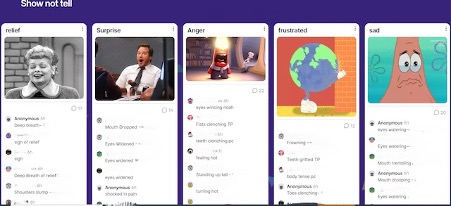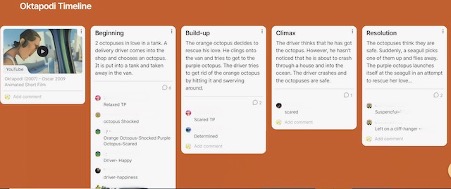Lesson Commentary
Introduction
The teacher begins with an introduction, in which he explains the aims for that morning’s lesson. He starts by referring to the Padlet that he created earlier. This Padlet was used to teach the children about writing emotions in narrative writing, using a ‘show, not tell’ technique (a technique to relate story and characters through sensory details and actions rather than exposition). The Padlet shows a number of well-known people and cartoon characters, with associated emotions. The children have previously used the Padlet 'comment option' to write a sentence that ‘shows, not tells’ an emotion for the character.

Padlet ‘Show, not Tell’
Explaining the Padlets
The teacher shares a second Oktapodi Timeline Padlet on the IWB. As with the previous Padlet, this Padlet was created for an earlier lesson, where the children used the comment function to write emotional responses to the events depicted for each stage of the story. This Padlet reinforces the ‘beginning, build-up, climax, resolution formula’ that the teacher is referring to. The Padlet also includes a section with a link to the Oktapodi film, that the children can play from within the Padlet, while working.

Padlet with story outline and link to film
Modelling on the IWB
The teacher next flips to another screen on the IWB, this time showing a Word document, which lists the learning objectives for today’s lesson. Children are listening and watching the IWB intently, and they are all quiet while the teacher explains the objectives of the lesson. The Word document stays on the IWB throughout the lesson for reference.

Today’s lesson objectives on the IWB
Digital and non-digital resources side by side
The teacher then moves to the Flipchart, which holds a pre-filled in worksheet (the same as the children will be using), which he uses to demonstrate a beginning and a build-up from the point of view of one of the characters in the story. The children are invited to come up and have a look at it at any point during the lesson. He reads out the written text, and there is a soft giggle around the class when he refers to ‘holding my loved one in my arms’. He explains the rest of the beginning and build-up example, and then moves to hand out the planning sheets.
Observations about engagement and enjoyment
Children were attentively listening to the teacher's explanations, asking questions and maintaining attention throughout. The Digital Resources on the IWB enabled a fast pace, which helped to instil a sense of excitement and helped to keep children focused on the task at hand.
